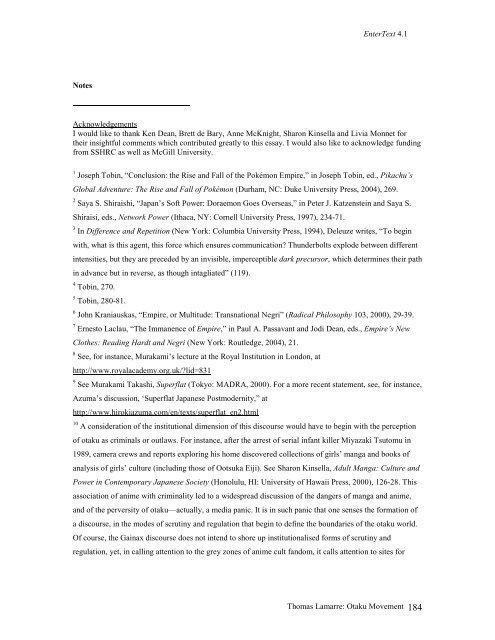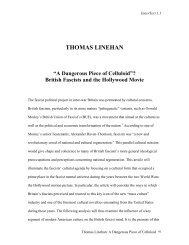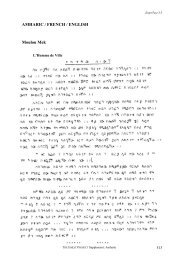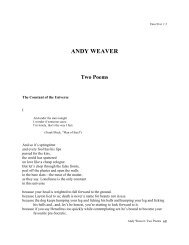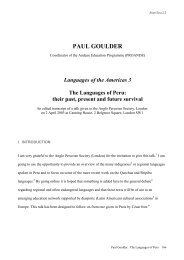Thomas Lamarre: An Introduction to Otaku Movement - Arts @ Brunel
Thomas Lamarre: An Introduction to Otaku Movement - Arts @ Brunel
Thomas Lamarre: An Introduction to Otaku Movement - Arts @ Brunel
You also want an ePaper? Increase the reach of your titles
YUMPU automatically turns print PDFs into web optimized ePapers that Google loves.
Notes<br />
EnterText 4.1<br />
Acknowledgements<br />
I would like <strong>to</strong> thank Ken Dean, Brett de Bary, <strong>An</strong>ne McKnight, Sharon Kinsella and Livia Monnet for<br />
their insightful comments which contributed greatly <strong>to</strong> this essay. I would also like <strong>to</strong> acknowledge funding<br />
from SSHRC as well as McGill University.<br />
1<br />
Joseph Tobin, “Conclusion: the Rise and Fall of the Pokémon Empire,” in Joseph Tobin, ed., Pikachu’s<br />
Global Adventure: The Rise and Fall of Pokémon (Durham, NC: Duke University Press, 2004), 269.<br />
2<br />
Saya S. Shiraishi, “Japan’s Soft Power: Doraemon Goes Overseas,” in Peter J. Katzenstein and Saya S.<br />
Shiraisi, eds., Network Power (Ithaca, NY: Cornell University Press, 1997), 234-71.<br />
3<br />
In Difference and Repetition (New York: Columbia University Press, 1994), Deleuze writes, “To begin<br />
with, what is this agent, this force which ensures communication? Thunderbolts explode between different<br />
intensities, but they are preceded by an invisible, imperceptible dark precursor, which determines their path<br />
in advance but in reverse, as though intagliated” (119).<br />
4<br />
Tobin, 270.<br />
5<br />
Tobin, 280-81.<br />
6<br />
John Kraniauskas, “Empire, or Multitude: Transnational Negri” (Radical Philosophy 103, 2000), 29-39.<br />
7<br />
Ernes<strong>to</strong> Laclau, “The Immanence of Empire,” in Paul A. Passavant and Jodi Dean, eds., Empire’s New<br />
Clothes: Reading Hardt and Negri (New York: Routledge, 2004), 21.<br />
8<br />
See, for instance, Murakami’s lecture at the Royal Institution in London, at<br />
http://www.royalacademy.org.uk/?lid=831<br />
9<br />
See Murakami Takashi, Superflat (Tokyo: MADRA, 2000). For a more recent statement, see, for instance,<br />
Azuma’s discussion, ‘Superflat Japanese Postmodernity,” at<br />
http://www.hirokiazuma.com/en/texts/superflat_en2.html<br />
10<br />
A consideration of the institutional dimension of this discourse would have <strong>to</strong> begin with the perception<br />
of otaku as criminals or outlaws. For instance, after the arrest of serial infant killer Miyazaki Tsu<strong>to</strong>mu in<br />
1989, camera crews and reports exploring his home discovered collections of girls’ manga and books of<br />
analysis of girls’ culture (including those of Ootsuka Eiji). See Sharon Kinsella, Adult Manga: Culture and<br />
Power in Contemporary Japanese Society (Honolulu, HI: University of Hawaii Press, 2000), 126-28. This<br />
association of anime with criminality led <strong>to</strong> a widespread discussion of the dangers of manga and anime,<br />
and of the perversity of otaku—actually, a media panic. It is in such panic that one senses the formation of<br />
a discourse, in the modes of scrutiny and regulation that begin <strong>to</strong> define the boundaries of the otaku world.<br />
Of course, the Gainax discourse does not intend <strong>to</strong> shore up institutionalised forms of scrutiny and<br />
regulation, yet, in calling attention <strong>to</strong> the grey zones of anime cult fandom, it calls attention <strong>to</strong> sites for<br />
<strong>Thomas</strong> <strong>Lamarre</strong>: <strong>Otaku</strong> <strong>Movement</strong> 184


